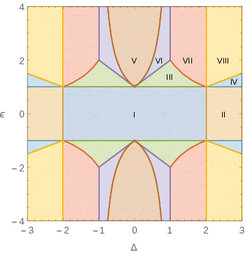Unveiling nonlocal correlations in natural systems
Nonlocal correlations are a quantum phenomenon that constitute a stronger form of correlations than quantum entanglement.
Researchers at MPQ, ICFO, University of Innsbruck and the Center for Theoretical Physics of the Polish Academy of Sciences have developed a new method to show that the low energy states of some physical spin Hamiltonians can exhibit these nonlocal correlations.

Classical correlations are part of our everyday experience. For instance, if one always puts on a pair of socks of the same colour and shape, looking at the colour or shape of one sock determines the colour or shape of the other one. Moreover, one can observe the colour and shape of one sock simultaneously, and these will tell us the colour and shape of the other one. Entangled states, the paradigmatic form of quantum correlations, defy this basic principle: if the socks were entangled, observing the colour of one sock would allow us to predict the colour of the other, but if, at the same time, we would observe the shape, this would “disturb” the colour, which would become completely unpredictable. This weird “coordination” between particles is known as quantum entanglement and is one of the intrinsic features of the quantum world
Some entangled states show an even weirder form of correlations, namely nonlocal correlations. These violate two apparently reasonable principles, namely (1) that the properties of objects (like shape or colour) exist regardless of our knowledge of them, and (2) that information cannot propagate instantaneously.
While fascinating, these nonlocal correlations are very hard to characterize in systems composed of many particles. There are at least three reasons for that: First, the classical correlations are mathematically very complex to study; second, quantum many-body states are very complex to describe as well due to the exponential growth of their description; and, third, currently available experimental techniques are rather limited, and this constrains the measurements that can be performed in the laboratory. In order to explore the role of nonlocal correlations in many-body quantum systems, one thus has to address these three problems at the same time.
In the work just published in Physical Review X 7, 021005 (Published 10 April 2017), an international research team composed of scientists from Munich, Barcelona, Innsbruck and Warsaw have proposed a new simple test to study nonlocal correlations in quantum many-body systems. This has allowed them to study whether nonlocal correlations appear in natural systems, more precisely, as ground states of some spin Hamiltonians, such as electrons (described by their spin degree of freedom) in a system of one spatial dimension. By combining numerical and analytical results, they have shown that some Hamiltonians that have been studied by physicists for some decades have a state of minimal energy which can display nonlocal correlations. This sheds some light onto this fascinating problem, hopefully sparking further progress in our understanding of nonlocality in quantum many-body systems.












